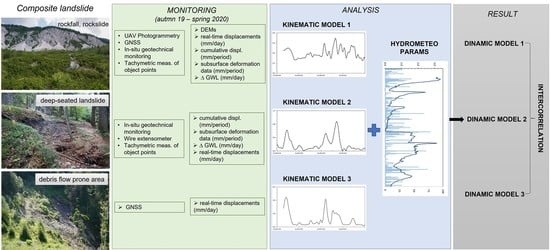Recognition of Landslide Triggering Mechanisms and Dynamics Using GNSS, UAV Photogrammetry and In Situ Monitoring Data
Abstract
:1. Introduction
2. Geological and Geomorphological Settings of the Case Study
3. Monitoring Methods
3.1. Remote Sensing
3.1.1. GNSS
3.1.2. UAV Photogrammetry
3.2. In Situ Geotechnical Monitoring
3.2.1. Wire Extensometer
3.2.2. Piezometers
3.2.3. Inclinometers
3.3. Geodetic Monitoring
4. Results
4.1. Surface Displacements
Interrelation of the Landslide Displacement Rate, Precipitation, and Groundwater Level Change
4.2. The Impact of Steep-Slope Erosion above the Main Scarp
5. Discussion
6. Conclusions
- Real-time surface displacements obtained from continuous monitoring using GNSS proved to be essential input data for landslide dynamics assessment and allowed us to obtain information on landslide kinematics.
- In situ electronic geotechnical devices (a wire extensometer in our case) show real time displacement trends comparable to those obtained by the GNSS method and could also serve as an internal control of the GNSS monitoring. The use of geotechnical devices on the site is less constrained by topography (open sky) and vegetation but shows a greater impact of external factors such as temperature variations, snow cover, and lightning strikes that need to be considered in data analysis.
- GNSS provided a cost-effective and easy-to-use method for monitoring landslide kinematics, but conventional in situ geotechnical and geodetic equipment and surveys are still essential for obtaining information about the depth of the sliding surface and groundwater dynamics.
- Additional remote sensors to allow continuous monitoring of surface displacements are required, especially on the main body of landslide. The monitoring network could be upgraded with additional in situ geotechnical equipment such as inclinometers because the current ones were destroyed due to landslide activity. Continuous measurement of the Bela stream flow would also add to the knowledge of the influence of surface water on landslide dynamics, especially in the area of the landslide toe, which is prone to debris flow.
- Before being implemented, new monitoring methods need to take into account constraints that could cause scattering for remote sensing: landslide orientation (northeast to southwest), area size, vegetation, lack of power supply and absence of infrastructure.
- Recent studies in Slovenia have shown that the frequency and intensity of precipitation events are expected to increase because of climate change [3], so the total and effective amount of rainfall, air temperature, evapotranspiration, and runoff from the Bela stream catchment are expected to increase [37].
Author Contributions
Funding
Data Availability Statement
Acknowledgments
Conflicts of Interest
References
- Haque, U.; Blum, P.; Da Silva, P.F.; Andersen, P.; Pilz, J.; Chalov, S.R.; Malet, J.-P.; Auflič, M.J.; Andres, N.; Poyiadji, E. Fatal landslides in Europe. Landslides 2016, 13, 1545–1554. [Google Scholar] [CrossRef]
- Herrera, G.; Mateos, R.M.; García-Davalillo, J.C.; Grandjean, G.; Poyiadji, E.; Maftei, R.; Filipciuc, T.-C.; Auflič, M.J.; Jež, J.; Podolszki, L. Landslide databases in the Geological Surveys of Europe. Landslides 2018, 15, 359–379. [Google Scholar] [CrossRef]
- Auflič, M.J.; Bokal, G.; Kumelj, Š.; Medved, A.; Dolinar, M.; Jež, J. Impact of climate change on landslides in Slovenia in the mid-21st century. Geologija 2021, 64, 159–171. [Google Scholar] [CrossRef]
- Jemec Auflič, M.; Jež, J.; Popit, T.; Košir, A.; Maček, M.; Logar, J.; Petkovšek, A.; Mikoš, M.; Calligaris, C.; Boccali, C. The variety of landslide forms in Slovenia and its immediate NW surroundings. Landslides 2017, 14, 1537–1546. [Google Scholar] [CrossRef]
- Froude, M.J.; Petley, D.N. Global fatal landslide occurrence from 2004 to 2016. Nat. Hazards Earth Syst. Sci. 2018, 18, 2161–2181. [Google Scholar] [CrossRef] [Green Version]
- Gariano, S.L.; Guzzetti, F. Landslides in a changing climate. Earth-Sci. Rev. 2016, 162, 227–252. [Google Scholar] [CrossRef] [Green Version]
- Lacroix, P.; Handwerger, A.L.; Bièvre, G. Life and death of slow-moving landslides. Nat. Rev. Earth Environ. 2020, 1, 404–419. [Google Scholar] [CrossRef]
- Li, H.; Xu, Q.; He, Y.; Deng, J. Prediction of landslide displacement with an ensemble-based extreme learning machine and copula models. Landslides 2018, 15, 2047–2059. [Google Scholar] [CrossRef]
- Chae, B.-G.; Park, H.-J.; Catani, F.; Simoni, A.; Berti, M. Landslide prediction, monitoring and early warning: A concise review of state-of-the-art. Geosci. J. 2017, 21, 1033–1070. [Google Scholar] [CrossRef]
- Huang, F.; Huang, J.; Jiang, S.; Zhou, C. Landslide displacement prediction based on multivariate chaotic model and extreme learning machine. Eng. Geol. 2017, 218, 173–186. [Google Scholar] [CrossRef]
- Gao, W.; Dai, S.; Chen, X. Landslide prediction based on a combination intelligent method using the GM and ENN: Two cases of landslides in the Three Gorges Reservoir, China. Landslides 2020, 17, 111–126. [Google Scholar] [CrossRef]
- Li, X.; Kong, J.; Wang, Z. Landslide displacement prediction based on combining method with optimal weight. Nat. Hazards 2012, 61, 635–646. [Google Scholar] [CrossRef]
- Arbanas, S.M.; Arbanas, Ž. Landslides: A guide to researching landslide phenomena and processes. In Transportation Systems and Engineering: Concepts, Methodologies, Tools, and Applications; IGI Global: Hershey, PA, USA, 2015; pp. 1393–1428. [Google Scholar]
- Uhlemann, S.; Smith, A.; Chambers, J.; Dixon, N.; Dijkstra, T.; Haslam, E.; Meldrum, P.; Merritt, A.; Gunn, D.; Mackay, J. Assessment of ground-based monitoring techniques applied to landslide investigations. Geomorphology 2016, 253, 438–451. [Google Scholar] [CrossRef] [Green Version]
- Pecoraro, G.; Calvello, M.; Piciullo, L. Monitoring strategies for local landslide early warning systems. Landslides 2019, 16, 213–231. [Google Scholar] [CrossRef]
- Mikoš, M. After 2000 Stože Landslide: Part I–Development in landslide research in Slovenia. Acta Hydrotech. 2020, 33, 129–153. [Google Scholar] [CrossRef]
- Mikoš, M. After 2000 Stože Landslide: Part II-Development of landslide disaster risk reduction policy in Slovenia. Acta Hydrotech. 2021, 34, 39–59. [Google Scholar] [CrossRef]
- Krkač, M.; Špoljarić, D.; Bernat, S.; Arbanas, S.M. Method for prediction of landslide movements based on random forests. Landslides 2017, 14, 947–960. [Google Scholar] [CrossRef]
- Krkač, M.; Bernat Gazibara, S.; Arbanas, Ž.; Sečanj, M.; Mihalić Arbanas, S. A comparative study of random forests and multiple linear regression in the prediction of landslide velocity. Landslides 2020, 17, 2515–2531. [Google Scholar] [CrossRef]
- Zhao, C.; Lu, Z. Remote sensing of landslides—A review. Remote Sens. 2018, 10, 279. [Google Scholar] [CrossRef] [Green Version]
- Peternel, T.; Kumelj, Š.; Oštir, K.; Komac, M. Monitoring the Potoška planina landslide (NW Slovenia) using UAV photogrammetry and tachymetric measurements. Landslides 2017, 14, 395–406. [Google Scholar] [CrossRef]
- Cruden, D.M.; Varnes, D.J. Landslides: Investigation and Mitigation. Chapter 3—Landslide Types and Processes; 030906208X; National Research Council: Washington, DC, USA, 1996; pp. 36–75. [Google Scholar]
- Jež, J.; Mikoš, M.; Trajanova, M.; Kumelj, Š.; Budkovič, T.; Bavec, M. Vršaj Koroška Bela-Rezultat katastrofičnih pobočnih dogodkov (Koroška Bela alluvial fan-The result of the catastrophic slope events; Kaeavanke Mountains, NW Slovenia). Geologija 2008, 51, 8. [Google Scholar] [CrossRef]
- Jemec Auflič, M.; Kumelj, Š.; Peternel, T.; Jež, J. Understanding of landslide risk through learning by doing: Case study of Koroška Bela community, Slovenia. Landslides 2019, 16, 1681–1690. [Google Scholar] [CrossRef] [Green Version]
- Peternel, T.; Jež, J.; Milanič, B.; Markelj, A.; Jemec Auflič, M. Engineering-geological conditions of landslides above the settlement of Koroška Bela (NW Slovenia). Geologija 2018, 61, 177–189. [Google Scholar] [CrossRef]
- Janža, M.; Serianz, L.; Šram, D.; Klasinc, M. Hydrogeological investigation of landslides Urbas and Čikla above the settlement of Koroška Bela (NW Slovenia). Geologija 2018, 61, 191–203. [Google Scholar] [CrossRef]
- Bezak, N.; Sodnik, J.; Maček, M.; Jurček, T.; Jež, J.; Peternel, T.; Mikoš, M. Investigation of potential debris flows above the Koroška Bela settlement, NW Slovenia, from hydro-technical and conceptual design perspectives. Landslides 2021, 18, 3891–3906. [Google Scholar] [CrossRef]
- Jež, J.; Peternel, T.; Milanič, B.; Markelj, A.; Novak, M.; Celarc, B.; Janža, M.; Jemec Auflič, M. Čikla landslide in Karavanke Mts. (NW Slovenia). In Proceedings of the 4th Regional Symposium on Landslides in the Adriatic—Balkan Region, Sarajevo, Bosnia and Herzegovina, 23–25 October 2019; pp. 239–242. [Google Scholar]
- Lavtižar, J. Zgodovina Župnij in Zvonovi v Dekaniji Radolica; (in Slovenian). Self-published by Lavtižar, J.: Ljubljana, Slovenia, 1897; p. 148. [Google Scholar]
- Zupan, G. Krajevni Leksikon Dravske Banovine; Uprava Krajevnega leksikona dravske banovine Ljubljana: Ljubljana, Slovenia, 1937; p. 540. [Google Scholar]
- Peternel, T.; Jež, J.; Janža, M.; Šegina, E.; Zupan, M.; Markelj, A.; Novak, A.; Jemec Auflič, M.; Logar, J.; Maček, M.; et al. Mountain slopes above Koroška Bela (NW Slovenia)—A landslide prone area. In Proceedings of the 5th Regional Symposium on Landslides in the Adriatic-Balkan Region, Rijeka, Croatia, 23–26 March 2022; pp. 13–18. [Google Scholar]
- Koren, K.; Serianz, L.; Janža, M. Characterizing the Groundwater Flow Regime in a Landslide Recharge Area Using Stable Isotopes: A Case Study of the Urbas Landslide Area in NW Slovenia. Water 2022, 14, 912. [Google Scholar] [CrossRef]
- Peternel, T.; Šegina, E.; Zupan, M.; Auflič, M.J.; Jež, J. Preliminary Result of Real-Time Landslide Monitoring in the Case of the Hinterland of Koroška Bela, NW Slovenia. In Proceedings of the Workshop on World Landslide Forum, Kyoto, Japan, 3 November 2020; pp. 459–464. [Google Scholar]
- Komac, M.; Holley, R.; Mahapatra, P.; van der Marel, H.; Bavec, M. Coupling of GPS/GNSS and radar interferometric data for a 3D surface displacement monitoring of landslides. Landslides 2015, 12, 241–257. [Google Scholar] [CrossRef]
- Komac, M.; Peternel, T.; Auflič, M.J. TXT-tool 2.386-2.1: SAR Interferometry as a Tool for Detection of Landslides in Early Phases. In Landslide Dynamics: ISDR-ICL Landslide Interactive Teaching Tools; Sassa, K., Guzzetti, F., Yamagishi, H., Arbanas, Ž., Casagli, N., McSaveney, M., Dang, K., Eds.; Springer: Berlin/Heidelberg, Germany, 2018; pp. 275–285. [Google Scholar]
- Peternel, T. Dinamika Pobočnih Masnih Premikov na Območju Potoške Planine z Uporabo Rezultatov Daljinskih in Terestričnih Geodetskih Opazovanj ter In-Situ Meritev: Doktorska Disertacija. Ph.D. Thesis, Univerza v Ljubljani, Naravoslovnotehniška fakulteta, Ljubljana, Slovenia, 2017. [Google Scholar]
- Bezak, N.; Peternel, T.; Medved, A.; Mikoš, M. Climate Change Impact Evaluation on the Water Balance of the Koroška Bela Area, NW Slovenia. In Proceedings of the Workshop on World Landslide Forum, Kyoto, Japan, 3 November 2020; pp. 221–228. [Google Scholar]
- Peternel, T.; Jež, J.; Milanič, B.; Markelj, A.; Sodnik, J.; Maček, M.; Jemec Auflič, M. Implementation of multidisciplinary approach for determination of landslide hazard. In Proceedings of the World Construction Forum 2019, Ljubljana, Slovenia, 8–11 April 2019; p. 124. [Google Scholar]
- Šegina, E.; Peternel, T.; Urbančič, T.; Realini, E.; Zupan, M.; Jež, J.; Caldera, S.; Gatti, A.; Tagliaferro, G.; Consoli, A. Monitoring Surface Displacement of a Deep-Seated Landslide by a Low-Cost and near Real-Time GNSS System. Remote Sens. 2020, 12, 3375. [Google Scholar] [CrossRef]
- Šegina, E.; Jemec Auflič, M.; Peternel, T.; Zupan, M.; Jež, J.; Realini, E.; Colomina, I.; Crosetto, M.; Consoli, A.; Luca, S. Validation and interpretation of data obtained by the newly developed low-cost Geodetic Integrated Monitoring System (GIMS). In Proceedings of the EGU General Assembly Conference Abstracts, Vienna, Austria, 3–8 May 2020; p. 5170. [Google Scholar]
- Lucieer, A.; Jong, S.M.d.; Turner, D. Mapping landslide displacements using Structure from Motion (SfM) and image correlation of multi-temporal UAV photography. Prog. Phys. Geogr. 2014, 38, 97–116. [Google Scholar] [CrossRef]
- d’Oleire-Oltmanns, S.; Marzolff, I.; Peter, K.D.; Ries, J.B. Unmanned aerial vehicle (UAV) for monitoring soil erosion in Morocco. Remote Sens. 2012, 4, 3390–3416. [Google Scholar] [CrossRef] [Green Version]
- Turner, D.; Lucieer, A.; De Jong, S.M. Time series analysis of landslide dynamics using an unmanned aerial vehicle (UAV). Remote Sens. 2015, 7, 1736–1757. [Google Scholar] [CrossRef] [Green Version]
- Fernández, T.; Pérez, J.L.; Cardenal, J.; Gómez, J.M.; Colomo, C.; Delgado, J. Analysis of landslide evolution affecting olive groves using UAV and photogrammetric techniques. Remote Sens. 2016, 8, 837. [Google Scholar] [CrossRef] [Green Version]
- Godone, D.; Allasia, P.; Borrelli, L.; Gullà, G. UAV and structure from motion approach to monitor the maierato landslide evolution. Remote Sens. 2020, 12, 1039. [Google Scholar] [CrossRef] [Green Version]
- Devoto, S.; Macovaz, V.; Mantovani, M.; Soldati, M.; Furlani, S. Advantages of using UAV digital photogrammetry in the study of slow-moving coastal landslides. Remote Sens. 2020, 12, 3566. [Google Scholar] [CrossRef]
- Liu, B.; He, K.; Han, M.; Hu, X.; Ma, G.; Wu, M. Application of uav and gb-sar in mechanism research and monitoring of zhonghaicun landslide in southwest China. Remote Sens. 2021, 13, 1653. [Google Scholar] [CrossRef]
- Gaidi, S.; Galve, J.P.; Melki, F.; Ruano, P.; Reyes-Carmona, C.; Marzougui, W.; Devoto, S.; Pérez-Peña, J.V.; Azañón, J.M.; Chouaieb, H. Analysis of the geological controls and kinematics of the chgega landslide (Mateur, Tunisia) exploiting photogrammetry and InSAR technologies. Remote Sens. 2021, 13, 4048. [Google Scholar] [CrossRef]
- Stumpf, A.; Malet, J.-P.; Allemand, P.; Pierrot-Deseilligny, M.; Skupinski, G. Ground-based multi-view photogrammetry for the monitoring of landslide deformation and erosion. Geomorphology 2015, 231, 130–145. [Google Scholar] [CrossRef]
- Stark, T.D.; Choi, H. Slope inclinometers for landslides. Landslides 2008, 5, 339–350. [Google Scholar] [CrossRef]
- Miao, F.; Wu, Y.; Xie, Y.; Li, Y. Prediction of landslide displacement with step-like behavior based on multialgorithm optimization and a support vector regression model. Landslides 2018, 15, 475–488. [Google Scholar] [CrossRef]
- Bogaard, T.; Greco, R. Invited perspectives: Hydrological perspectives on precipitation intensity-duration thresholds for landslide initiation: Proposing hydro-meteorological thresholds. Nat. Hazards Earth Syst. Sci. 2018, 18, 31–39. [Google Scholar] [CrossRef] [Green Version]
- Yang, B.; Yin, K.; Lacasse, S.; Liu, Z. Time series analysis and long short-term memory neural network to predict landslide displacement. Landslides 2019, 16, 677–694. [Google Scholar] [CrossRef]
- Schober, P.; Boer, C.; Schwarte, L.A. Correlation coefficients: Appropriate use and interpretation. Anesth. Analg. 2018, 126, 1763–1768. [Google Scholar] [CrossRef] [PubMed]


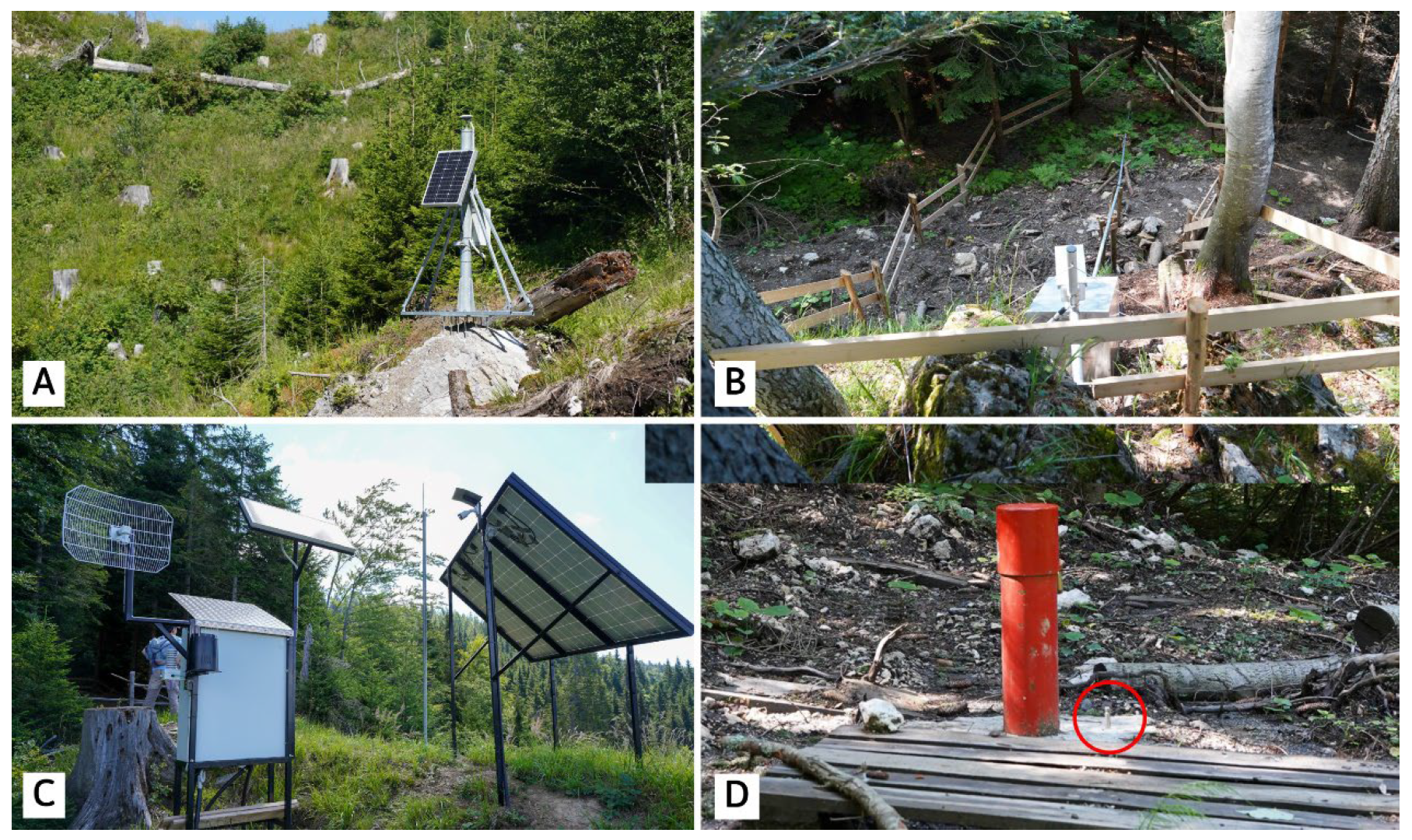


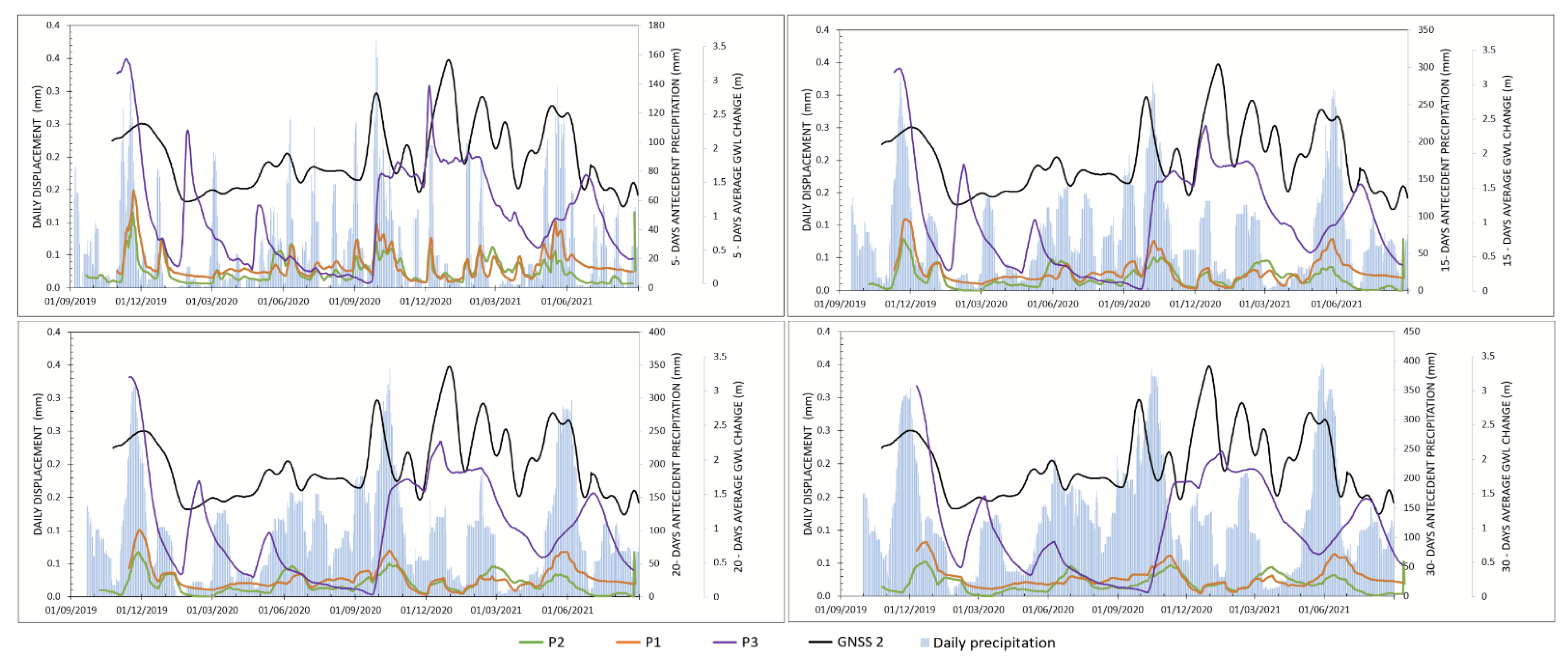
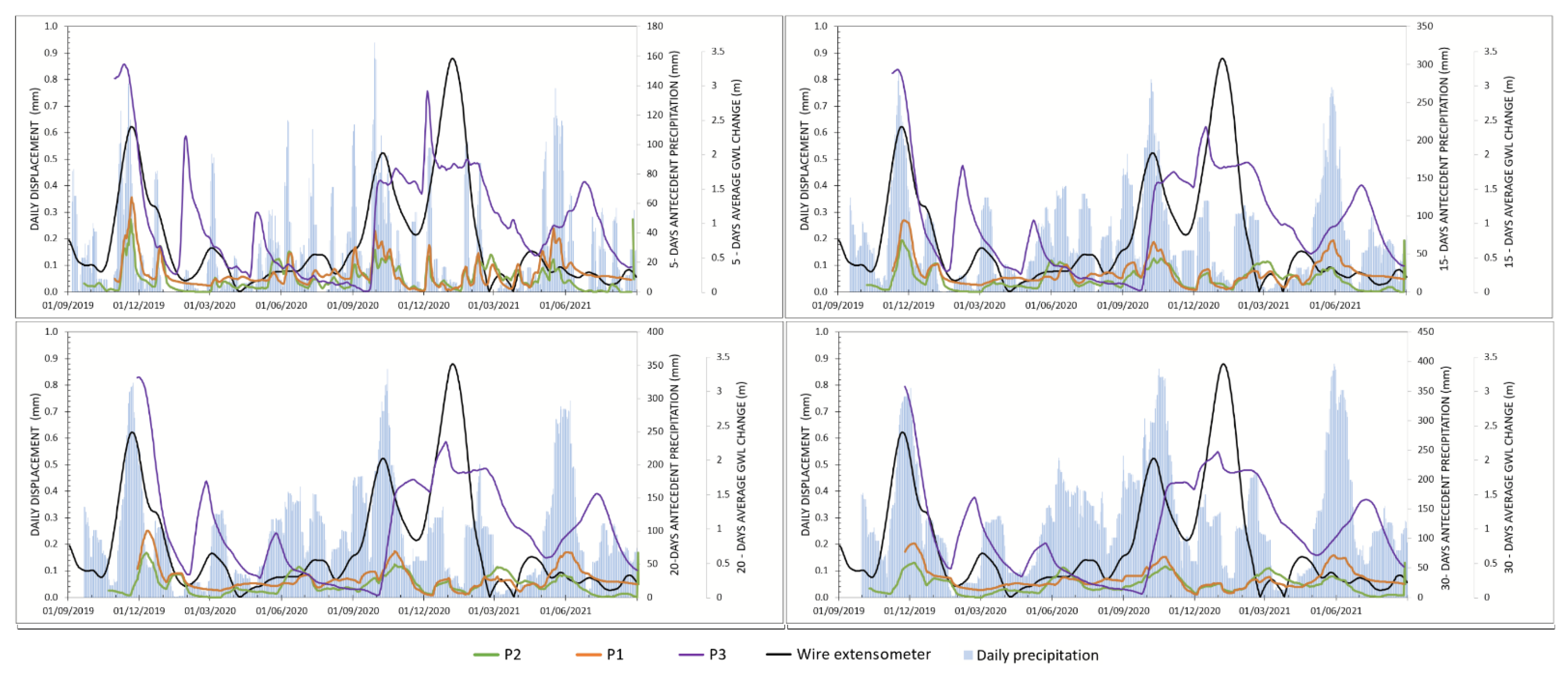
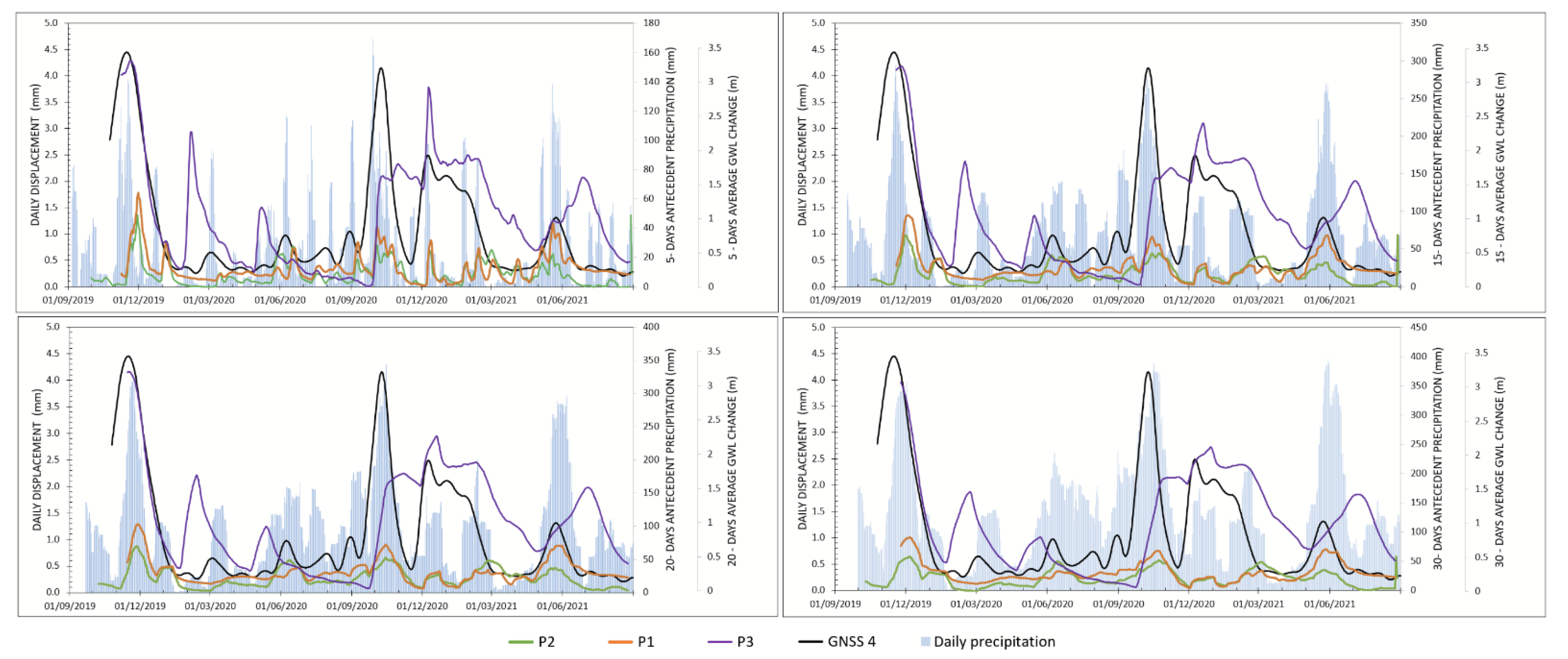
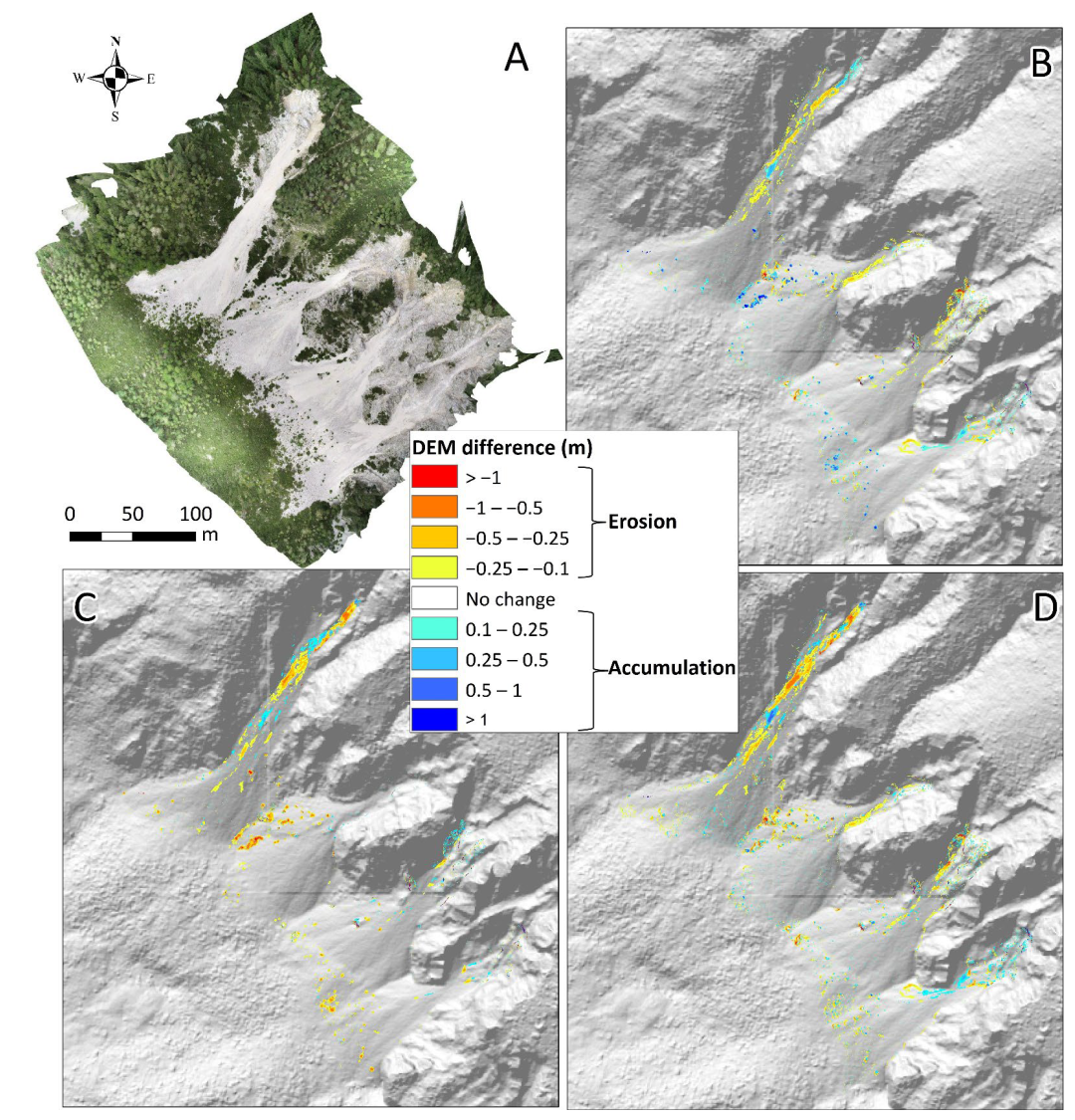
| Piezometer | Ground Surface Altitude (m a.s.l.) | Depth (m) | Depth of Screened Interval (m) |
|---|---|---|---|
| P1 | 1289.2 | 21.0 | 6.9–18.9 |
| P2 | 1232.4 | 15.0 | 2.5–5.5 |
| 6.0–12.0 | |||
| P3 | 1218.8 | 30.0 | 6.7–15.7 |
| Area (m2) | Volume Change (m3) | ||||
|---|---|---|---|---|---|
| DEM Diff. | Erosion | Accumulation | No Change | Erosion | Accumulation |
| 10 Aug 2019–14 May 2020 | 1846 | 1350 | 28,256 | 881 | 806 |
| 14 May 2020–19 Aug 2020 | 1806 | 528 | 29,118 | 890 | 431 |
| 10 Aug 2019–19 Aug 2020 | 2838 | 1186 | 27,428 | 1230 | 695 |
| Hydrometeorological Parameters | Correlation Coefficient (r) | |||
|---|---|---|---|---|
| GNSS2 | Wire Extensometer | GNSS4 | ||
| 5 | -days antecedent precipitation | 0.27 | 0.19 | 0.41 |
| 10 | 0.33 | 0.24 | 0.49 | |
| 15 | 0.35 | 0.28 | 0.53 | |
| 20 | 0.37 | 0.29 | 0.54 | |
| 30 | 0.39 | 0.29 | 0.52 | |
| 5 | piezometer P1 -days average GWL change | 0.32 | 0.21 | 0.55 |
| 10 | 0.34 | 0.22 | 0.58 | |
| 15 | 0.35 | 0.22 | 0.59 | |
| 20 | 0.34 | 0.21 | 0.57 | |
| 30 | 0.29 | 0.15 | 0.47 | |
| 5 | piezometer P2 -days average GWL change | 0.42 | 0.23 | 0.48 |
| 10 | 0.45 | 0.24 | 0.48 | |
| 15 | 0.47 | 0.24 | 0.46 | |
| 20 | 0.47 | 0.23 | 0.43 | |
| 30 | 0.43 | 0.20 | 0.35 | |
| 5 | piezometer P3 -days average GWL change | 0.40 | 0.54 | 0.65 |
| 10 | 0.41 | 0.56 | 0.63 | |
| 15 | 0.41 | 0.56 | 0.60 | |
| 20 | 0.41 | 0.56 | 0.55 | |
| 30 | 0.41 | 0.51 | 0.44 | |
Publisher’s Note: MDPI stays neutral with regard to jurisdictional claims in published maps and institutional affiliations. |
© 2022 by the authors. Licensee MDPI, Basel, Switzerland. This article is an open access article distributed under the terms and conditions of the Creative Commons Attribution (CC BY) license (https://creativecommons.org/licenses/by/4.0/).
Share and Cite
Peternel, T.; Janža, M.; Šegina, E.; Bezak, N.; Maček, M. Recognition of Landslide Triggering Mechanisms and Dynamics Using GNSS, UAV Photogrammetry and In Situ Monitoring Data. Remote Sens. 2022, 14, 3277. https://doi.org/10.3390/rs14143277
Peternel T, Janža M, Šegina E, Bezak N, Maček M. Recognition of Landslide Triggering Mechanisms and Dynamics Using GNSS, UAV Photogrammetry and In Situ Monitoring Data. Remote Sensing. 2022; 14(14):3277. https://doi.org/10.3390/rs14143277
Chicago/Turabian StylePeternel, Tina, Mitja Janža, Ela Šegina, Nejc Bezak, and Matej Maček. 2022. "Recognition of Landslide Triggering Mechanisms and Dynamics Using GNSS, UAV Photogrammetry and In Situ Monitoring Data" Remote Sensing 14, no. 14: 3277. https://doi.org/10.3390/rs14143277
APA StylePeternel, T., Janža, M., Šegina, E., Bezak, N., & Maček, M. (2022). Recognition of Landslide Triggering Mechanisms and Dynamics Using GNSS, UAV Photogrammetry and In Situ Monitoring Data. Remote Sensing, 14(14), 3277. https://doi.org/10.3390/rs14143277






